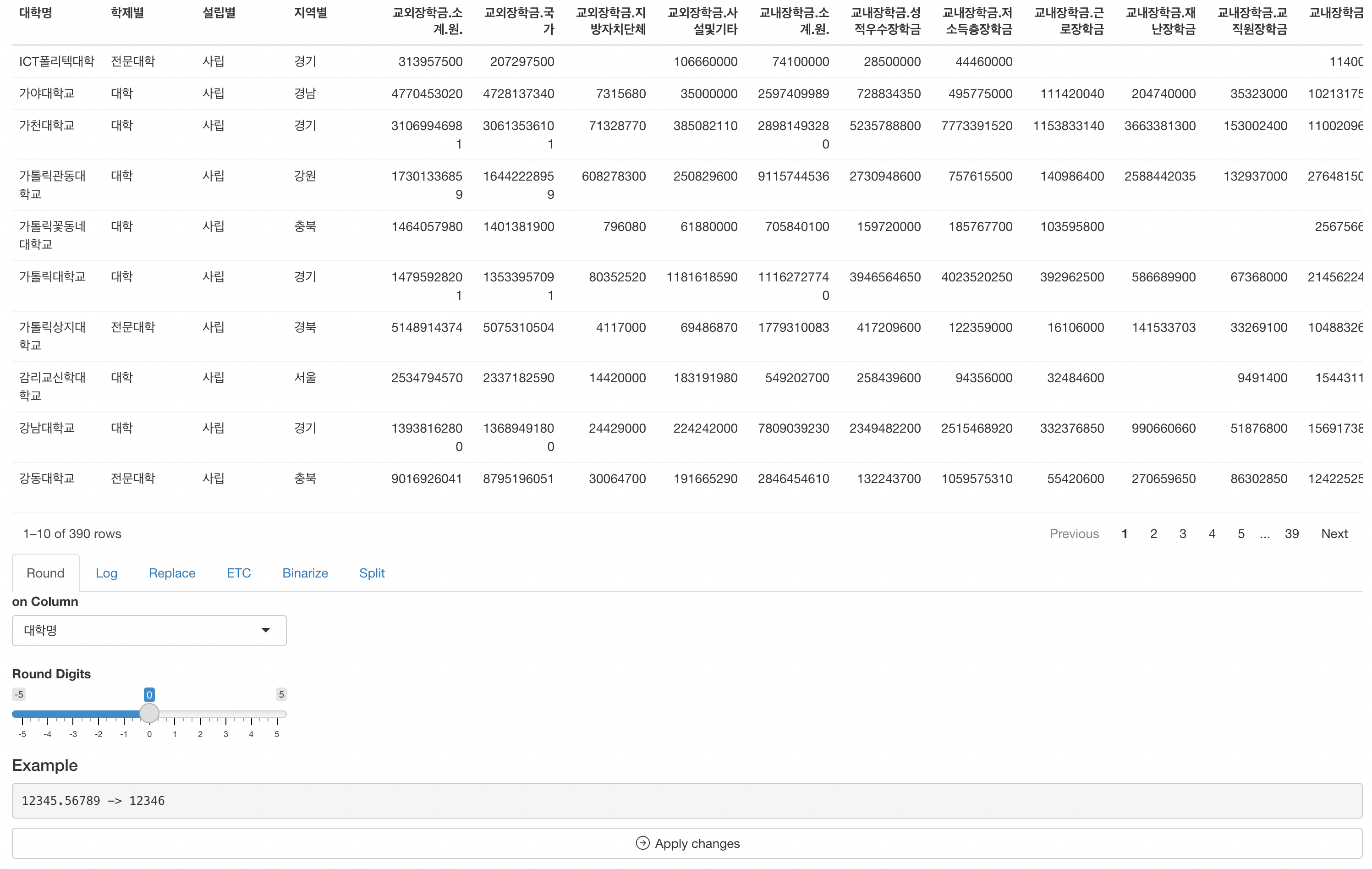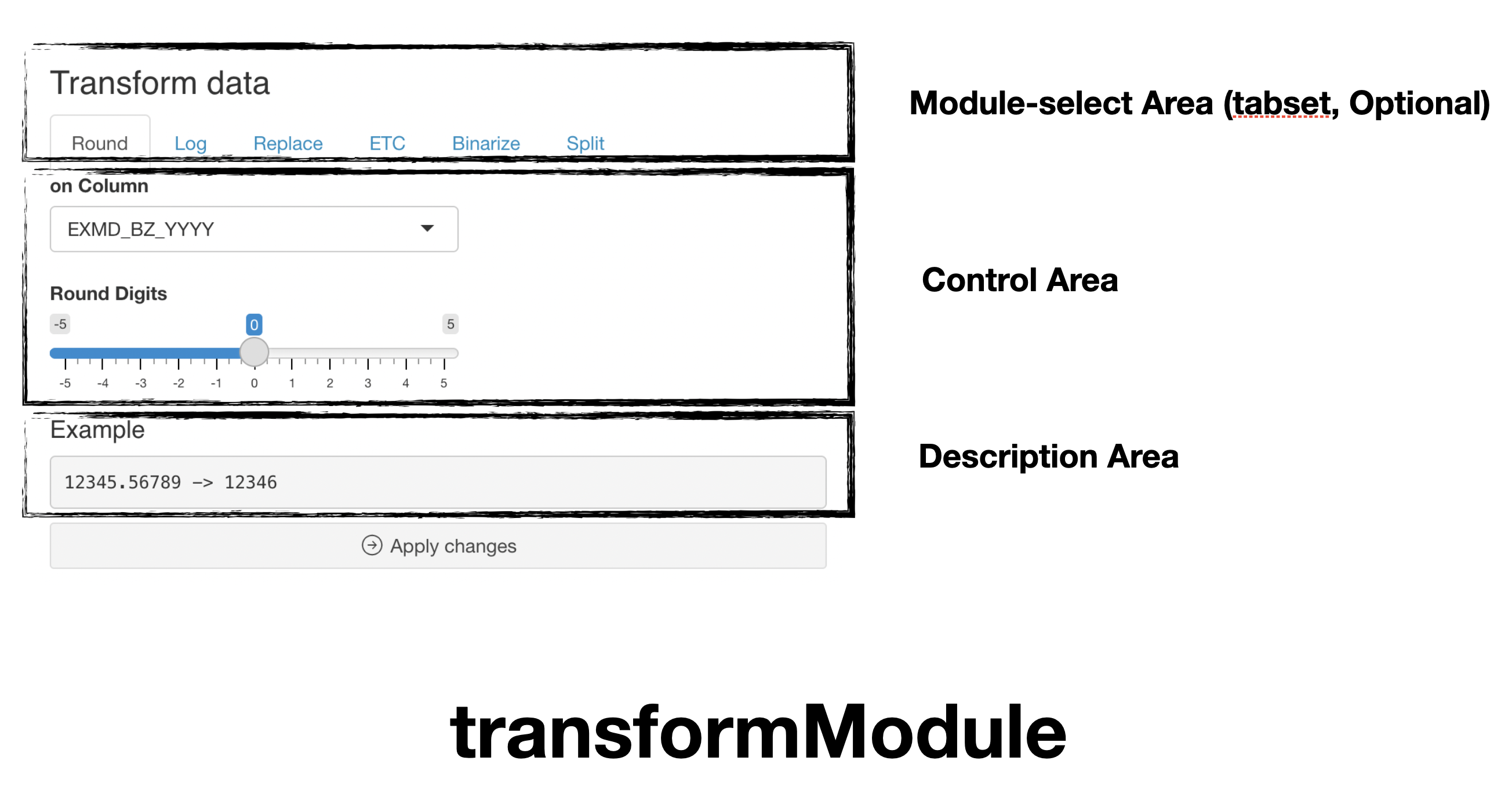
How to use transformModule
Source:vignettes/articles/usage-transform-Module.Rmd
usage-transform-Module.RmdIntroduction
There are similar modules to transform data. Below are list of them.
- Binarize
- ETC
- Log
- Replace
- Round
- Split
and in this article, we call them as
transformModule.
scissor’s transformModule transforms
selected variables.
In this article, we’ll use scholarship dataset of datatoys
This article is based on 0.2.0 Version of scissor.
Declare module
scissor’s module assumes that used in the Shiny application.
and You can use snippet(type shinyapp) to build very
basic shiny application.
library(shiny)
ui <- fluidPage(
)
server <- function(input, output, session) {
}
shinyApp(ui, server)This application will show nothing.
So let’s add binarizeModule in ui
ui <- fluidPage(
mod_binarizeModule_ui(
id = 'binModule'
)
)also, binarizeModule in server.
server <- function(input, output, session) {
mod_binarizeModule_server(
id = 'binModule',
inputData = reactive(datatoys::scholarship)
)
}So final (which is very basic) code will like this.
library(shiny)
ui <- fluidPage(
mod_binarizeModule_ui(
id = 'binModule'
)
)
server <- function(input, output, session) {
mod_binarizeModule_server(
id = 'binModule',
inputData = reactive(datatoys::scholarship) # remotes::install_github('statgarten/datatoys')
)
}
shinyApp(ui, server) # run applicationYou should notice 3 things.
- Both
idin ui and server should be same. -
inputDatain server should be format of reactive - This exampple may declare module, but it will not work.
Using multiple modules
As mentioned, there are other modules,
So let’s add ETCModule to both ui and
server
ui <- fluidPage(
mod_binarizeModule_ui(
id = 'binModule'
),
mod_etcModule_ui(
id = 'etcModule'
)
)
server <- function(input, output, session) {
mod_binarizeModule_server(
id = 'binModule',
inputData = reactive(datatoys::scholarship) # remotes::install_github('statgarten/datatoys')
)
mod_etcModule_server(
id = 'etcModule',
inputData = reactive(datatoys::scholarship)
)
}
shinyApp(ui, server) # run applicationHere is three big problems.
- Each module’s UI will simultaneously added to below. (which looks bad)
- Each module’s transform will be independent. That is, even
binModulechange column A,etcModulewill not recognize it. - Module’s transform will not effect to
inputData
So here’s one usage of door that utilize this
scissor module.
library(shiny)
ui <- fluidPage(
reactable::reactableOutput('table'), # view data
tabsetPanel( # Modules as tabset
id = "transformPanel",
tabPanel(
title = "Round",
mod_roundModule_ui("roundModule_1")
),
tabPanel( # Log2 / Log / Log10
title = "Log",
mod_logModule_ui("logModule_1")
),
tabPanel(
title = "Replace",
mod_replaceModule_ui("replaceModule_1")
),
tabPanel(
title = "ETC",
mod_etcModule_ui("etcModule_1")
),
tabPanel(
title = "Binarize",
mod_binarizeModule_ui("binModule_1")
),
tabPanel(
title = "Split",
mod_splitModule_ui(id = "splitModule_1")
)
),
actionButton( # actionbutton to apply transform
inputId = "applyTransform",
label = tagList(
phosphoricons::ph("arrow-circle-right"),
"Apply changes"
),
width = "100%"
)
)
server <- function(input, output, session) {
# Data handling
inputData <- reactive(datatoys::scholarship)
data_rv <- reactiveValues(data = NULL)
observeEvent(inputData(), {
data_rv$data <- inputData()
})
# Data view
output$table <- reactable::renderReactable({
reactable::reactable(data_rv$data)
})
# Data transform
res_round <- mod_roundModule_server(
id = "roundModule_1",
inputData = reactive(data_rv$data)
)
## log Module
res_log <- mod_logModule_server(
id = "logModule_1",
inputData = reactive(data_rv$data)
)
## replace Module
res_replace <- mod_replaceModule_server(
id = "replaceModule_1",
inputData = reactive(data_rv$data)
)
## binarize Module
res_binary <- mod_binarizeModule_server(
id = "binModule_1",
inputData = reactive(data_rv$data)
)
## etc Module
res_trans <- mod_etcModule_server(
id = "etcModule_1",
inputData = reactive(data_rv$data)
)
## Split Module
res_split <- mod_splitModule_server(
id = "splitModule_1",
inputData = reactive(data_rv$data)
)
# update data
observeEvent(input$applyTransform, {
if (input$transformPanel == "Round") {
data_rv$data <- res_round()
}
if (input$transformPanel == "Log") {
data_rv$data <- res_log()
}
if (input$transformPanel == "Replace") {
data_rv$data <- res_replace()
}
if (input$transformPanel == "Binarize") {
data_rv$data <- res_binary()
}
if (input$transformPanel == "ETC") {
data_rv$data <- res_trans()
}
if (input$transformPanel == "Split") {
data_rv$data <- res_split()
}
inputData(data_rv$data) # then use isolated
})
}
shinyApp(ui, server) # run application
Note that, module consist or layout may change by user’s goal.
However, we strongly recommend utilize these modules as
tabsetpanel or modal
And finally, Action button for transform must be added
(it is not included in module now. but we consider it in further update
version)
Structure of transformModule

transformModule is consisted with Control Area and
Description Area (no Result Area)
Description area explains expected transform result with
example control options.
and below is using flow.
- Declare module (we did already)
- Select function and column to transform, and apply button
- Finish (result should be linked to view like
table)
For any issue or suggestion, please make issue in scissor’s github.